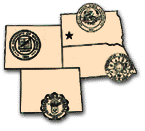Animal Science, Department of

Range Beef Cow Symposium
Date of this Version
December 2005
Document Type
Article
Abstract
The ability to forecast annual forage yield from weather data would be useful for making appropriate adjustments to stocking rates in order to achieve or maintain desired plant communities. Identifying the key weather variables that determine forage yield would help managers focus their attention on what to measure and when to make grazing decisions.
Stocking rate decisions are critical in determining long-range sustainability and productivity of range ecosystems and ultimately the financial success of ranches. Over-stocking of rangeland has led to reduced vegetative cover, increased runoff of water and sediment, and increased weedy forbs and woody plant species. All of these factors and others lead to a shift in species composition to less productive vegetation which negatively impacts animal production management opportunities. Therefore enhancing the grassland manager’s sensitivity to seasonal influences of weather patterns on forage production will enable managers to make timely stocking rate adjustments. The earlier this information is available to the producer to make annual forage production estimates, the better the manager will be in position to initiate necessary grazing changes.


Comments
Published for the Proceedings, The Range Beef Cow Symposium XIX December 6, 7 and 8, 2005, Rapid City, South Dakota.